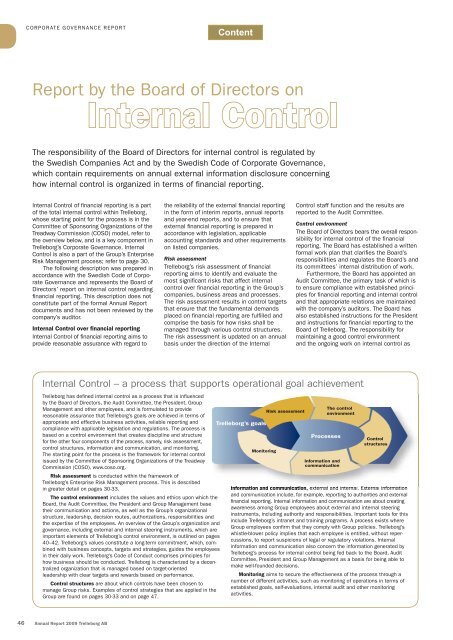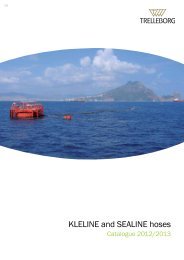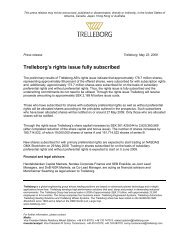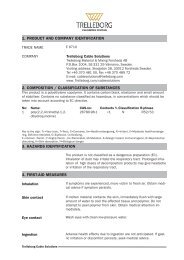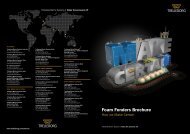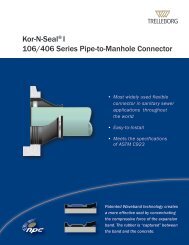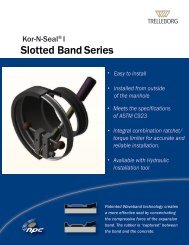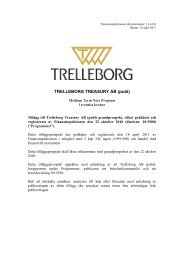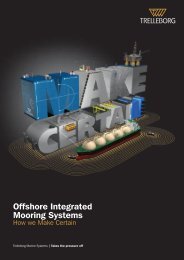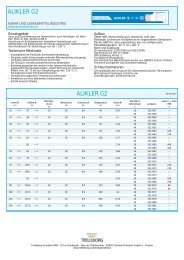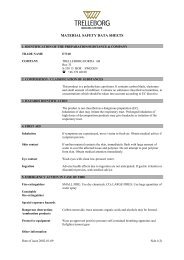Internal Control - Trelleborg
Internal Control - Trelleborg
Internal Control - Trelleborg
You also want an ePaper? Increase the reach of your titles
YUMPU automatically turns print PDFs into web optimized ePapers that Google loves.
CORPORATE GOVERNANCE REPORT<br />
Report by the Board of Directors on<br />
<strong>Internal</strong> <strong>Control</strong><br />
The responsibility of the Board of Directors for internal control is regulated by<br />
the Swedish Companies Act and by the Swedish Code of Corporate Governance,<br />
which contain requirements on annual external information disclosure concerning<br />
how internal control is organized in terms of financial reporting.<br />
<strong>Internal</strong> <strong>Control</strong> of financial reporting is a part<br />
of the total internal control within <strong>Trelleborg</strong>,<br />
whose starting point for the process is in the<br />
Committee of Sponsoring Organizations of the<br />
Treadway Commission (COSO) model, refer to<br />
the overview below, and is a key component in<br />
<strong>Trelleborg</strong>’s Corporate Governance. <strong>Internal</strong><br />
<strong>Control</strong> is also a part of the Group’s Enterprise<br />
Risk Management process; refer to page 30.<br />
The following description was prepared in<br />
accordance with the Swedish Code of Corporate<br />
Governance and represents the Board of<br />
Directors’ report on internal control regarding<br />
financial reporting. This description does not<br />
constitute part of the formal Annual Report<br />
documents and has not been reviewed by the<br />
company’s auditor.<br />
<strong>Internal</strong> <strong>Control</strong> over financial reporting<br />
<strong>Internal</strong> <strong>Control</strong> of financial reporting aims to<br />
provide reasonable assurance with regard to<br />
the reliability of the external financial reporting<br />
in the form of interim reports, annual reports<br />
and year-end reports, and to ensure that<br />
external financial reporting is prepared in<br />
accordance with legislation, applicable<br />
accounting standards and other requirements<br />
on listed companies.<br />
Risk assessment<br />
<strong>Trelleborg</strong>’s risk assessment of financial<br />
reporting aims to identify and evaluate the<br />
most significant risks that affect internal<br />
control over financial reporting in the Group’s<br />
companies, business areas and processes.<br />
The risk assessment results in control targets<br />
that ensure that the fundamental demands<br />
placed on financial reporting are fulfilled and<br />
comprise the basis for how risks shall be<br />
managed through various control structures.<br />
The risk assessment is updated on an annual<br />
basis under the direction of the <strong>Internal</strong><br />
<strong>Control</strong> staff function and the results are<br />
reported to the Audit Committee.<br />
<strong>Control</strong> environment<br />
The Board of Directors bears the overall responsibility<br />
for internal control of the financial<br />
reporting. The Board has established a written<br />
formal work plan that clarifies the Board’s<br />
responsibilities and regulates the Board’s and<br />
its committees’ internal distribution of work.<br />
Furthermore, the Board has appointed an<br />
Audit Committee, the primary task of which is<br />
to ensure compliance with established principles<br />
for financial reporting and internal control<br />
and that appropriate relations are maintained<br />
with the company’s auditors. The Board has<br />
also established instructions for the President<br />
and instructions for financial reporting to the<br />
Board of <strong>Trelleborg</strong>. The responsibility for<br />
maintaining a good control environment<br />
and the ongoing work on internal control as<br />
<strong>Internal</strong> <strong>Control</strong> – a process that supports operational goal achievement<br />
<strong>Trelleborg</strong> has defined internal control as a process that is influenced<br />
by the Board of Directors, the Audit Committee, the President, Group<br />
Management and other employees, and is formulated to provide<br />
reasonable assurance that <strong>Trelleborg</strong>’s goals are achieved in terms of<br />
appropriate and effective business activities, reliable reporting and<br />
compliance with applicable legislation and regulations. The process is<br />
based on a control environment that creates discipline and structure<br />
for the other four components of the process, namely, risk assessment,<br />
control structures, information and communication, and monitoring.<br />
The starting point for the process is the framework for internal control<br />
issued by the Committee of Sponsoring Organizations of the Treadway<br />
Commission (COSO), www.coso.org.<br />
Risk assessment is conducted within the framework of<br />
<strong>Trelleborg</strong>’s Enterprise Risk Management process. This is described<br />
in greater detail on pages 30-33.<br />
The control environment includes the values and ethics upon which the<br />
Board, the Audit Committee, the President and Group Management base<br />
their communication and actions, as well as the Group’s organizational<br />
structure, leadership, decision routes, authorizations, responsibilities and<br />
the expertise of the employees. An overview of the Group’s organization and<br />
governance, including external and internal steering instruments, which are<br />
important elements of <strong>Trelleborg</strong>’s control environment, is outlined on pages<br />
40–42. <strong>Trelleborg</strong>’s values constitute a long-term commitment, which, combined<br />
with business concepts, targets and strategies, guides the employees<br />
in their daily work. <strong>Trelleborg</strong>’s Code of Conduct comprises principles for<br />
how business should be conducted. <strong>Trelleborg</strong> is characterized by a decentralized<br />
organization that is managed based on target-oriented<br />
leadership with clear targets and rewards based on performance.<br />
<strong>Control</strong> structures are about which controls have been chosen to<br />
manage Group risks. Examples of control strategies that are applied in the<br />
Group are found on pages 30-33 and on page 47.<br />
<strong>Trelleborg</strong>’s goals<br />
Monitoring<br />
Risk assessment<br />
The control<br />
environment<br />
Processes<br />
Information and<br />
communication<br />
<strong>Control</strong><br />
structures<br />
Information and communication, external and internal. External information<br />
and communication include, for example, reporting to authorities and external<br />
financial reporting. <strong>Internal</strong> information and communication are about creating<br />
awareness among Group employees about external and internal steering<br />
instruments, including authority and responsibilities. Important tools for this<br />
include <strong>Trelleborg</strong>’s intranet and training programs. A process exists where<br />
Group employees confirm that they comply with Group policies. <strong>Trelleborg</strong>’s<br />
whistle-blower policy implies that each employee is entitled, without repercussions,<br />
to report suspicions of legal or regulatory violations. <strong>Internal</strong><br />
information and communication also concern the information generated by<br />
<strong>Trelleborg</strong>’s process for internal control being fed back to the Board, Audit<br />
Committee, President and Group Management as a basis for being able to<br />
make well-founded decisions.<br />
Monitoring aims to secure the effectiveness of the process through a<br />
number of different activities, such as monitoring of operations in terms of<br />
established goals, self-evaluations, internal audit and other monitoring<br />
activities.<br />
46<br />
Annual Report 2009 <strong>Trelleborg</strong> AB
CORPORATE GOVERNANCE REPORT<br />
regards the financial reporting is delegated to<br />
the President. The Group’s <strong>Internal</strong> <strong>Control</strong><br />
staff function works as the Group’s internal<br />
audit function and reports to the Audit Committee<br />
and the Group’s CFO. The function<br />
focuses on developing and enhancing internal<br />
control over the financial reporting in the<br />
Group by proactively concentrating on the<br />
internal control environment and by examining<br />
the effectiveness of the internal control.<br />
<strong>Internal</strong> steering instruments for financial<br />
reporting primarily comprise the Group’s<br />
Treasury Policy, Communication Policy and<br />
Finance Manual, which define the accounting<br />
and reporting rules, and the Group’s definition<br />
of processes and minimum requirements for<br />
internal control over financial reporting.<br />
<strong>Control</strong> structures<br />
The most significant risks identified as<br />
regards financial reporting are managed<br />
through control structures in companies,<br />
business areas and processes. Management<br />
may entail that these risks are accepted,<br />
reduced or eliminated. The purpose of the<br />
control structures is to ensure efficiency in<br />
the Group’s processes and good internal<br />
control and is based on the Group’s minimum<br />
requirements for good internal control in<br />
defined, significant processes, which is<br />
demonstrated in the diagram below. Minimum<br />
requirements comprise more general and<br />
detailed controls and can be both preventive<br />
and detective in nature. These have been<br />
subdivided into A and B levels, according to<br />
which the A level shall be applied by all of the<br />
companies in the Group and the B<br />
level by only the Group’s largest companies.<br />
Information and Communication<br />
Information and communication regarding<br />
internal steering instruments for financial<br />
reporting are available to all employees<br />
concerned on <strong>Trelleborg</strong>’s intranet. Information<br />
and communicaton relating to financial<br />
reporting is also provided through training.<br />
In the Group, there is a process by which<br />
all relevant employees confirm compliance<br />
with <strong>Trelleborg</strong>’s policies on an annual basis.<br />
The Group’s CFO and the Head of the <strong>Internal</strong><br />
<strong>Control</strong> staff function report the results of<br />
their work on internal control as a standing<br />
item on the agenda of the Audit Committee’s<br />
meetings. The results of the Audit Committee’s<br />
work in the form of observations,<br />
recommendations and proposed decisions<br />
and measures are continuously reported to<br />
the Board. External financial reporting is<br />
performed in accordance with relevant<br />
external and internal steering instruments.<br />
Monitoring<br />
Monitoring to ensure the effectiveness of<br />
internal control in terms of financial reporting<br />
is conducted by the Board, the Audit Committee,<br />
the President, Group Management, the<br />
<strong>Internal</strong> <strong>Control</strong> staff function and by the<br />
Group’s companies and business areas.<br />
Monitoring includes the follow-up of monthly<br />
financial reports in relation to budget and<br />
targets, as well as quarterly reports with<br />
results from self-assessments in the Group’s<br />
companies and business areas, and results<br />
from internal audits. The <strong>Internal</strong> <strong>Control</strong> staff<br />
function works in accordance with an annual<br />
plan that is approved by the Audit Committee.<br />
The plan is based on the risk analysis and<br />
encompasses prioritized companies, business<br />
areas and processes, as well as work<br />
programs and budgets.<br />
Activities in 2009<br />
Under the supervision of the <strong>Internal</strong> <strong>Control</strong><br />
staff function, 25 internal audits in eight<br />
countries were performed during the year. The<br />
audits were conducted either by an internal<br />
team comprising the <strong>Internal</strong> <strong>Control</strong> staff<br />
function in cooperation with other staff functions<br />
with specialist competence in such<br />
areas as purchasing, cash-flow management<br />
and finance or, in relation to IT security<br />
audits, by a team comprising the head of Group<br />
IT in cooperation with external consultants.<br />
In 2009, there was major focus on<br />
processes affecting cash flow, such as the<br />
sales process, the inventory process and the<br />
purchasing process, which was a new process<br />
in 2009. In 2009, the Group was successful<br />
in improving cash flow. Enhanced processes<br />
and controls contributed to this. IT security<br />
was also an area of focus in 2009, which<br />
resulted in several improvement measures at<br />
Group level and in the Group’s companies<br />
and processes.<br />
In 2009, an intranet section for <strong>Internal</strong><br />
<strong>Control</strong> was developed, giving employees<br />
access to standardized tools and documents,<br />
as well as examples of operational solutions.<br />
The aim of this is to provide increased support<br />
for the Group’s companies and business<br />
areas to be able to meet the Group’s minimum<br />
internal control requirements in relation to<br />
financial reporting.<br />
Focus in 2010<br />
In 2010, the <strong>Internal</strong> <strong>Control</strong> staff function<br />
will continue to focus on processes affecting<br />
cash flow. Furthermore, new minimum<br />
requirements for good internal control will be<br />
introduced for the salary-management<br />
process, including pensions and other<br />
remuneration.<br />
During the year, the cooperation between<br />
the <strong>Internal</strong> <strong>Control</strong> staff function and the<br />
Group Legal and Risk Management staff<br />
functions, which are primarily responsible for<br />
the ERM process, will be further developed<br />
and intensified.<br />
<strong>Trelleborg</strong>, February 16, 2010<br />
The Board of Directors of <strong>Trelleborg</strong><br />
Significant processes – Self-evaluation, <strong>Internal</strong> auditing, Training/Tools<br />
Company 1<br />
Company 2<br />
Business area 1 Business area 2 Purchasing Treasury Etc.<br />
Self-evaluation <strong>Internal</strong> audit Training/tools<br />
Purchasing process<br />
Inventory process<br />
Sales process<br />
Process for assets<br />
Financial report and<br />
reporting processes<br />
IT security process<br />
Groupwide reporting system with<br />
quarterly feedback from subsidiaries<br />
Subsidiaries respond to how they<br />
comply with the Group’s minimum<br />
requirements for good internal<br />
control in selected processes<br />
Deficiencies identified, measures<br />
planned and implemented by the<br />
companies<br />
Includes approximately 100 subsidiaries,<br />
of which the largest approximately<br />
40 companies shall apply<br />
both A and B levels in terms of minimum<br />
levels for good internal control<br />
and the approximately 60 smaller<br />
companies will only apply the A level<br />
About 250 minimum requirements<br />
for good internal control<br />
All relevant employees confirm<br />
annually their compliance with the<br />
Group’s policies.<br />
<strong>Internal</strong> audits are conducted by the<br />
<strong>Internal</strong> <strong>Control</strong> staff function in<br />
cooperation with internal resources<br />
from other staff functions<br />
<strong>Internal</strong> audits of IT security are<br />
carried out by the head of Group IT<br />
together with external consultants<br />
Comprises six selected processes<br />
and about 250 minimum requirements<br />
for good internal control<br />
<strong>Internal</strong> audits result in observations,<br />
recommendations and<br />
proposals for decisions and<br />
measures<br />
Identified deficiencies are followed<br />
up on a quarterly basis by business<br />
area controllers and the <strong>Internal</strong><br />
<strong>Control</strong> staff function.<br />
A number of training programs in<br />
defined processes relating to minimum<br />
requirements for good internal<br />
control took place in 2009<br />
Training programs are aimed at<br />
increasing knowledge levels and<br />
understanding pertaining to efficient<br />
processes and good internal control<br />
Training programs are a forum for<br />
the exchange of experience and<br />
sharing best practice<br />
A new intranet section has been<br />
available since 2009 to provide<br />
employees access to standardized<br />
tools and documents, as well as<br />
examples of business solutions.<br />
Annual Report 2009 <strong>Trelleborg</strong> AB 47


